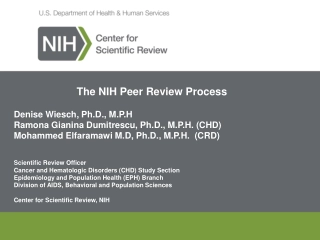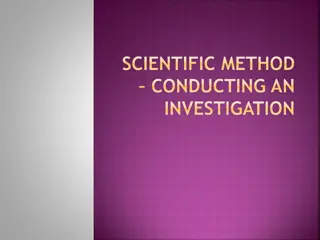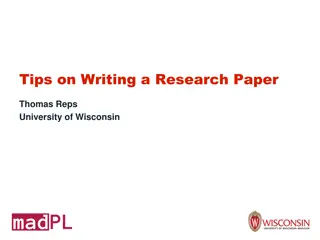Writing a Scientific Paper and Navigating the Review Process
Engage in the process of writing a scientific paper, understand the significant role of peer review, and learn valuable insights on dealing with co-authors and selecting appropriate journals for publication. Embrace the essence of contributing to human knowledge through your research endeavors.
Download Presentation

Please find below an Image/Link to download the presentation.
The content on the website is provided AS IS for your information and personal use only. It may not be sold, licensed, or shared on other websites without obtaining consent from the author.If you encounter any issues during the download, it is possible that the publisher has removed the file from their server.
You are allowed to download the files provided on this website for personal or commercial use, subject to the condition that they are used lawfully. All files are the property of their respective owners.
The content on the website is provided AS IS for your information and personal use only. It may not be sold, licensed, or shared on other websites without obtaining consent from the author.
E N D
Presentation Transcript
How to write a scientific paper and how to deal with the review process Daniel J. Jacob, Harvard University
A scientific paper is an addition to human knowledge Sharks (reviewers) Ocean of Ignorance Island of Human Knowledge your paper (not to scale) This can be knowledge of the natural world, of the human experience, or how to do things better. Once a paper is published in the peer-reviewed literature it represents an official new frontier of knowledge for humankind hence the importance of the review process. Just remember the focus is new knowledge. Your paper has a lot that s new, and a lot that s true unfortunately they don t overlap
Scientific papers are the metric of academic productivity (see Preparing for a Research Career) What determines the quality of a scientific paper? Appreciation by peers - originality - readability - pedagogy - usefulness all of which require excellent writing! There s really no point in discovering new things if you don t share it with the world The paper plants the flag the idea now belongs to you Scientific papers (well-advertised) establish your personal brand Scientists are driven by two things: (1) to understand the world, (2) to get credit for it
Where should I publish? The EGU journals (ACP for science results, GMD and AMT for methods) have become our standard disciplinary journals. JGR, AE are also fine but ACP has eaten their lunch GRL for short scientific communications ES&T for general interest PNAS, Nature xxx, Science xxx for paradigm-changing papers of general interest Etiquette for co-authors, acknowledgments? Any scientist who has done work specifically for your paper should be co- author Any scientist who has developed a recent capability that is important for your work should be offered co-authorship Useful discussions don t warrant co-authorship (just acknowledgments) Order matters only for senior author (second or last), others can be grouped by situation, ordered alphabetically Scientists are very sensitive to co-authorships it doesn t hurt to be inclusive.
Few will read your paper from beginning to end Think of how scientists (you!) read papers ! Title and abstract are for the search engines most readers will not go beyond the abstract. Figures + captions and Tables + footnotes must be self-contained a lot of readers go through those without reading the text. Some may look for quick explanation in text, so discussion of figures/tables in text should jump at reader (start paragraphs with Figure X shows ) Make your figures attractive for use in presentations, both by you and others. If you wouldn t use a figure in a presentation, then fix or delete the figure! Many readers are interested in your paper mainly because they want some specific numbers, or a synthesis or references to previous work, or to understand the issue you re working on; oblige by being scholarly and pedagogical The take-home messages of the paper should be in your face , I.e., in abstract, in intro, in conclusions, to make sure the diagonal reader gets the message.
How to structure your paper It depends on journal. All expect an Abstract and an Intro. ES&T imposes the structure 1. Intro 2. Data and Methods 3. Results and Discussion. PNAS, Nature make you put the Data and Methods at the end. Other journals are more flexible The ES&T structure may work for you (also for other journals), maybe with subsections and conclusions (or not). Or it may be awkward, for example if it s better to describe datasets as you use them in the results section. It really depends on the paper. Don t go beyond subsections to sub-subsections. That starts to make your paper hard to read and suggests it s too long. How to get over writer s block Three strategies: Write an outline and then gradually fill it in Have a list of Figures and start writing around the Figures (Figure X shows ) (my way) Write the whole thing in one sitting, very early on (before work is complete), forcing yourself to write stuff even if it s gibberish. Have another drink. At the end you will have SOMETHING that you just need to edit.
Introduction Write it early (before work is done), revisit often; it forces you to think about what your paper is about and how it advances knowledge Classical approach: begin with a mini-review and finish the intro by saying what your paper is about Better (I think), more direct approach: First paragraph: state succinctly the problem you re addressing and why it s important, in a way that can be appreciated by someone outside the field At end of first paragraph or beginning of second: tell us in one sentence what your paper is about Second and following paragraphs: now that you told us what your paper is about, give us the background information, what people have done before, etc. This has to cite all the relevant literature (use search engines) Last paragraph: tell us how your work will go beyond what s been done before and what your approach will be. For a letter paper the intro should be no more than 1-2 paragraphs; just condense the framework above
A few words about references Showing command of the literature is extremely important. You need to describe the foundation on which your contribution to human knowledge is based. Thorough referencing is the scholarly and ethical thing to do, it avoids annoying your peers, it s also useful to readers and it makes your paper more accessible by search engines. So be serious about literature search and reading papers comb the literature using search engines. Never cite a paper for which you haven t read at least the relevant part. Cite papers in a context that makes it clear what the paper did otherwise the reference is useless. If you re not clear on what the paper you re citing actually did, go back and (re-)read the paper it s the intellectually honest thing to do and you may learn something. There s nothing wrong with citing yourself extensively in fact that s normal since that s the work you typically build on, and that s part of advertising. But don t ignore what others have done and what they learned, particularly other models References should be helpful to the reader, not of historical interest
Methods section following the Intro Write this as soon as you think that your methods are mature the writing process will make you check whether they really are Often you ll be working with a complicated model or using a messy data set. Focus your methods section solely on what is important for your paper. Reference other papers for peripheral information. Read papers from the group to see how we generally handle model description. Don t reinvent the wheel but put things in your own words. Your methods may include information of specific interest to readers such as chemical mechanisms, budget tables, equations, etc. Make sure those are prominent and self-contained so readers can easily grab them without having to wade through the rest of your paper
A few words about math Math is good - equations are often necessary to describe methods, but can also be an excellent way to set the stage sometimes your arguments can be encapsulated neatly in an equation. But avoid peripheral equations don t force the reader to understand something that s not crucial to the paper There is no excuse for math errors, and readers will judge you harshly - check and re-check, including in proof. Define all terms in your equations. Your notation should be textbook-quality. Don t use words or multi-letter variables in equations. Use standard notation and terminology as much as possible it makes it easier for the reader to follow.
Results sections If not clear from the Section title, start the section with a brief statement of what it s about Start by presenting your results (Figure X shows ) and then discuss what they mean including comparisons to prior work Comparing to previous relevant work is important it puts your results in context and acknowledges what others have done. Logical, linear flow of thought is essential you ve thought a lot about your results and what they mean, share this progression with reader. Tell a story. One theme per paragraph first sentence lays out the theme, last sentence provides link to next paragraph. Few paragraphs need to be longer than page longer than 1 page is sure sign of confused thinking. Don t wring your hands about lack of confidence in your results! The reader expects you to focus on what you can say with confidence.
A few words about comparing model with observations Comparisons with observations should have a purpose in terms of learning about the atmosphere or about your model. You should tell us why you are comparing to this particular data set, what features you re looking for No one cares that the model does a good job , is in reasonable agreement , etc. What are you actually learning from the model? What level of agreement would you expect? What increased confidence in terms of processes are you getting from the comparison? Can you usefully make the comparison quantitative? Don t be complacent about the model. You may be naturally anxious to show that the model does a good job so that you can go on with your application but that doesn t come across well if flaws are apparent. Maybe the flaws don t matter, or maybe they do and require a caveat, or maybe the focus of the work has to be on understanding the flaw. Nobody believes a modeling paper except the author, everybody believes an observational paper except the author
Abstract and Conclusions can wait to be written until rest of paper is mature Abstract is the most important part of the paper many readers will read just that. Focus on what is new - essential ideas, essential numbers. One fact/idea per sentence. Everything that you would like the reader to remember should be there. Anything you say in Conclusions should be backed by the text. The Conclusions section gives the take-home messages of your paper in a way that s not as severely limited in space as the Abstract. The few readers who go through your whole paper will read the Conclusions to make sure they got things right. Other readers will skip straight from Abstract to Conclusions, or skip to Conclusions after trying to wade through the paper and getting discouraged. Here s an easy recipe for the Conclusions section which will make your writing easy and will be most useful to readers: First paragraph: quick summary of what you did and why you did it. Successive paragraphs: one paragraph per section, following the flow of the paper and extracting the take-home messages. Don t use the Conclusions to offer future perspectives or to talk about future work (OK, do it in the final paragraph if you must). Readers are generally not interested. Some journals (GRL, ES&T) don t expect conclusions, Instead, just have the last paragraph start with In summary, we have and give the conclusions.
Some general editorial remarks Read your draft from the perspective of a critical reader. Are you satisfied? Is this a great paper? Be as short as possible. Every word must hurt . Use short words (e.g., use vs. utiilize ) and strong effective words with precise meaning. Try to use short sentences. Try using active present form. Remove value judgments: Surprising , interesting , unfortunately have no place in a scientific paper. Play with the English language to express your message in a direct and interesting way that people will appreciate. Beware of words with different scientific vs. lay meanings, such as significant , ideal , reduce . Use them in their scientific meaning when there can be any ambiguity. Be consistent in notation and terminology. Ozone or O3 ? Communication is better if you write as you would speak. Which means for example ozone , CO , SO2 , sulfate , etc. In the same vein, if you experience writer s block think about how you would express yourself orally and then write it that way. - Dr. X, your presentation was just superfluous! When will it be published? Dr. X: It will be published posthumously Wonderful! I can t wait!
The review process and being a reviewer By scientific community rules, peer-reviewed literature represents the body of scientific knowledge and all scientists are expected to be familiar with it. which makes reviewing papers an important responsibility! As a reviewer, you re the gatekeeper to the trove of human knowledge. And yet you re doing it on a volunteer anonymous basis! Isn t it amazing that the system works? The trove of human knowledge will be polluted if papers are published that are (1) wrong, (2) don t add significant knowledge. As a reviewer you must can those papers, for the sake of the scientific community. At the same time, don t set your standards too high. Consider that the authors generally need to publish to satisfy their sponsors. A paper doesn t have to be great to be publishable. Decision on publishing the paper is made by the Editor. Your role as reviewer is only to advise the Editor. Which means that (1) you don t need to comment on stuff where you don t have expertise; (2) you shouldn t get furious if the Editor doesn t follow your advice.
Some suggestions for writing a review Try not to create more work for the authors. Surely the work could be improved but you re not a co-author, so that s not your job. Surely additional work could be done but that s generally not feasible, the student may have graduated or the funding run out. Does the work as it stand provide a useful contribution to human knowledge? That should be your yardstick. Remember that the authors are not interested in you making their paper better. They re interested in publishing. You re just standing in their way. The authors have thought about the content of their paper a lot more than you have. On the other hand, you re a more sophisticated reader than most. This calls for a combination of humility and forthrightness. If you don t understand some aspect of the paper it s the authors problem, not yours. Rather than assume that the authors are wrong, ask them to clarify ? Authors will view any criticism of their work as an aggression. Express it in personal terms to make it less aggressive: In my opinion, , I couldn t understand , I wasn t convinced , I don t see how Sometimes the English is atrocious. This is not your problem to fix. Just tell the Editor that the English needs to be improved.
How to respond to a review Criticism from an anonymous reviewer is very hard to take, (1) Give the criticism a chance could the reviewer be right? Think about it overnight. (2) Generally the reviewer is wrong (see previous lesson about humility) but it s your problem that s/he was mistaken so fix it! Even when the inescapable conclusion is that the reviewer is just an idiot, keep in mind that s/he is a more sophisticated reader than most. Respond to the comments in the text of your paper. Don t engage in a private dialog with the reviewer, that s not the point of the review process. It s best to respond to comments by saying that you ve actually changed something in the paper to accommodate the reviewer s comments (partly = OK). Sometimes the reviewer has a hostility that makes you think they just want to prevent you from publishing. That s generally paranoid thinking (would you do this?). But some reviewers may just not agree with you and at some point you just have to ask that they agree to disagree and they generally will. You can also appeal to the Editor for arbitration.























